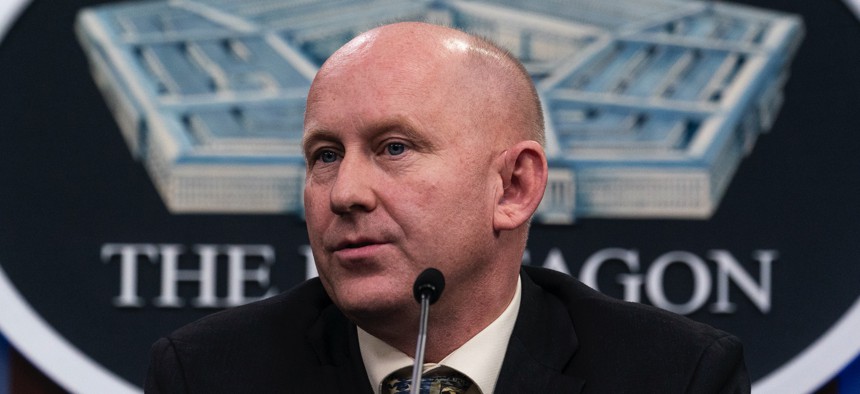
Acting Army Secretary John Whitley speaks during a media briefing at the Pentagon, Monday, Jan. 25, 2021, in Washington. AP / Alex Brandon
‘A Lot of Risk’ in Army’s Proposed 2022 Budget, Service Leaders Say
As details remain under wraps, lawmakers fret about possible cuts.
There is one thing that Congressional representatives and the Army’s top leaders seem to agree on: the service’s upcoming budget request is not going to be what anyone wants.
“I think there is a lot of risk in the budget,” John Whitley, the acting Army Secretary, said Wednesday during a hearing before the House Appropriations defense subcommittee.
Little is publicly known about the Biden administration’s 2022 defense spending request, except that it will be submitted to Congress far later than usual, and that its $715 billion top line is a slight increase from this year’s $705 billion. In March, Army Chief of Staff Gen. James McConville hinted that the spending plan would force him to choose between better weapons and more soldiers.
At the hearing, most of the representatives voiced their concern about not yet knowing what the Army may face to their 2022 funding. Some were also concerned the $715 billion was not enough to meet the national security requirements and expectations for the military. Whitley said that the Army’s budget has remained essentially flat over the past three years.
“I’m afraid that when we do have a budget that we can talk about, we’re not going to be pleased with the results because it’s going to force us into making some terrible decisions,” said Rep. Steve Womack, R-Ark. “We have to come to grips as a country if we’re going to accept less resources, those requirements are going to have to be pared down as well.”
Whitley said that the Army learned during the last sequestration that funding cuts can be deep and it can take a long time to rebuild. The Army is only in a good place today because of investments and realignments made within the service, he said.
Cuts to investments in modernization for the Army could make the current level of readiness for the service to become “fragile,” according to Whitely and Gen. James McConville, the chief of staff of the Army.
The budget’s risks are placed on backs of the soldiers and their families, who could see them deploy more than they should, McConville said.
Rep. John Carter, R-Texas, voiced his concern that it seemed the Army is going to take “the lion’s share of the cuts” when it comes to the budget.
Carter may have been referring to the Navy, which has a more obvious role to play in a defense strategy oriented toward the Asia-Pacific theater, and which has been making a case for a far larger fleet to counter China’s. In March, the chairman of the House seapower committee, Rep. Joe Courtney, D-Conn., began saying in public that the Navy should receive a larger slice of the 2022 defense budget than the other services.
But Whitley said the Army is already overstretched when it comes to meeting requirements with the force it has now.
McConville said he would like to increase the end strength of the active force to 550,000, up from 485,000 today, if the demand on the service remains the same, but he said he understands they cannot afford it based on what he’s seen with the budgets.
The Army must then keep investing in the readiness and modernization of the force it does have, considering the competition in the world, he said.
A cut in modernization funding for systems like the Abrams tank could mean that the Army has to slow down its plans, according to McConville.
“We’re going to have to come back once we see what the resources are, and that may drive us to make some tough decisions that people are not going to like,” he said.
The drawdown in Afghanistan may also affect 2022 spending, with soldiers making up most of the forces currently in the country. While the service is still estimating how much the drawdown could cost the Army as people and equipment are moved out of the country, Whitley conceded that predicting the actual costs is difficult and will probably be more than expected.
There may be hope for the Army when it comes to more funding. Rep. Tom Cole, R-Okla., reminded the committee’s members that “we can do what we want here.” He pointed to how they increased former President Donald Trump’s first budget request in 2017 because they believed it was not enough.
He said there will probably have to be a deal made to increase funding for the military at the cost of Biden’s domestic program priorities.




